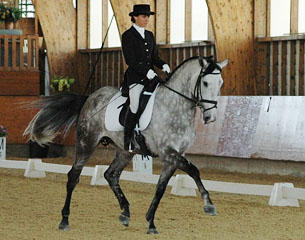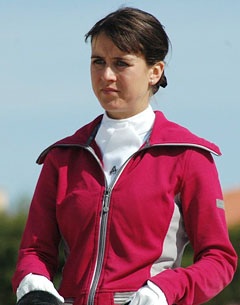
Everyone has a different idea about weekly training schedules for horses. Lunge once a week, don't lunge once a week, one day off, no days off, one day walking out, one day work in hand etc etc. In honesty, most of the training schedules are more to suit the rider than the horse.
A professional takes a day off to give the horses a rest. Translation: he would go insane riding 20 horses a day if he didn't at least rest his bum for 24 hours.
But the bottom line...every horse is different, and while the top stables have so many horses they are forced to create a more BULK training schedule, most of us have the luxury of deciding what is right for our individual horse!
The two horses I have in training at the moment are POLAR OPPOSITES, what one does well, the other needs to work on, which is a positive as it allows me to feel on one what I need to improve on with the other.
But just like human athletes, one is older, one is younger, one has an attitude of Work hard and concentrated, and one has the concentration span of a 6 year old...and believe it or not, that is not the one that is actually 6!
The older of my horses, Ulisses, is a 10 year old Lusitano with a definite mix of Arabian blood! This creates a hock activity unlike most I have seen, but also a tendency to hollow in the back the minute things get tricky!
Batialo on the other hand plays when he is feeling fresh, but when push comes to shove, he is in concentration mode. The ears NEVER lie.... Batialos will flop outwards... relaxed, listening, while Ulisse's look like they have bees in them, buzzing around all over the place!
With Ulisses, his schedule requires him a day off to relax, so that he will look forward to being ridden. If I ride him all days I feel like he is rolling his eyes at me, and saying, "Well I'm bit sick of this after 10 years"! After his day off he feels more willing to try, and also rested through his joints. Batialo on the other hand gets more fresh, and the 'Play' attitude that would be ok for an Edward Gal, becomes a little dangerous for me to ride.
There is again major debate over lunging; whether it is useful, or whether it is essential, and or how often it should be employed! A lot of the stables in Europe lunge all their horses once a week, BUT, Australia is different, and because horses are let out in paddocks all day it is not so much of a requirement.
On the other hand lunging CORRECTLY can be very beneficial for the horse, helping him build up the correct muscle, while also allowing him to move freely without the rider.
 BUT lunging is an ART, and only those who are well experienced with it will do it justice. Lunging badly is just letting your horse run around in circles, fall out through the shoulder, and generally get away with whatever he wants! If you, LIKE ME, have the patience of a 4 year old, and the lunging technique of a should be cowboy, then you are better off just going for a walk out on your horse and giving you both a chance to relax!
BUT lunging is an ART, and only those who are well experienced with it will do it justice. Lunging badly is just letting your horse run around in circles, fall out through the shoulder, and generally get away with whatever he wants! If you, LIKE ME, have the patience of a 4 year old, and the lunging technique of a should be cowboy, then you are better off just going for a walk out on your horse and giving you both a chance to relax!
Work in hand is also extremely worthwhile, but again only if you know what you are doing, cause seriously, otherwise you are just leading a horse around. If you are not well schooled in the technique of work in hand there is a lot of work you can do on your horse at the walk that achieves the same goals.
Working the walk is crucial, and if you can get your horse moving freely and sensitively off your leg at the walk, and are able to move from shoulder-in to traverse and then into half-pass without losing the rhythm and balance of the walk, these movements when asked for in the trot and canter will be a breeze!
Start on a circle in walk, and keeping the bend to the inside ask the horse to move away from your inside leg ensuring the shoulders don't ground, and that all four legs move sideways with ease and relaxation. Then release the inside leg and keeping the bend to the inside use the outside leg to move the horse on a big circle of shoulder-in. This not only makes the horse sensitive to your leg aids, but also lifts him up off the shoulders and engages his hind leg right from the beginning!
And finally, I know of horses that can only be ridden 3 or 4 times a week at the most, because they are older or stiffer, or they may be young and need time to mature.
Whatever the reason, every horse has a different agenda, just like some of us have 3 days good- 4 bad, or vice versa. Someone said to me one day at the stable..."It's a public holiday, why are you here?" First I didn't know it was one, and second the horse doesn't know it's a public holiday, he isn't going to tax me extra or form a picket line in protest!
In addition, I ride my horse everyday, one day just walking out, but like humans, horses have their days, and it may be that for one week you may need to back right off the work while the horse adjusts, or you may need to REALLY work him for a week, and not give him a rest day, while you win a subtle argument!
 The week when Batialo went through his "I'm in charge just try and stop me" phase, it would NOT have been a good idea to give him one day walking out...first of all I would have ended up on the other side of Portugal, and second it would have set me back in my determination to ride him through it.
The week when Batialo went through his "I'm in charge just try and stop me" phase, it would NOT have been a good idea to give him one day walking out...first of all I would have ended up on the other side of Portugal, and second it would have set me back in my determination to ride him through it.
Gradually, day by day, he accepted that I was the boss, but this took persistence and reminding! The reward was that when he did come back under me, responding to my half halt, balancing himself in the rhythm, and allowing me to open my fingers and let him stretch his neck, he was again allowed his day out for a walking adventure.
So of course the schedule for every horse and rider is different, and it is only from knowing the horse, and not trying to be too restricted in your plan, that you can accommodate for all the moods, weather patterns, physical capacity, arrogance/impatience (from both horse and rider...lol)!
Then once you start competing it gets even more complex...!
How often should I train the test movements? How many days should I bring his frame up for collection, and for how long? A lot of top competition riders say they only practice test movements for a small portion of each lesson, and some will even tell you they avoid doing the entire test until a few days before. Of course a less experienced rider needs to practice the test in it's entirety... more for their own learning than for the horses.
Collection is where the debate gets tricky... Just like a runner doesn't sprint everyday, or for long periods, a horse must be worked far more in the gymnastics and relaxation of dressage, than in the sprint, aka collection.
João Moreira, a Portuguese young rider whom I admire greatly, gave me some great advice. He said that the collection should be done in short bursts, but more than that is should be DEFINITE.
"A horse should recognize that the minute I sit myself up tall and really sit him back, that this is the frame and attitude I want for the 10 minute duration of the test. For those 10 minutes in training I work on the collection, the transitions, the movements of the test.. And when the 10 minutes is up, just as definitively as I commenced the collection, I relax my body, the reins, the attitude, and neck, and tell the horse to resume relaxation. That way he doesn't get half way through the test and try to back off, fall forward, lose impulsion, or drop his neck!"
 Also, it may seem obvious, but a lot of people will go to clinics, where they work the horse hard, and up for long periods, and really try to engage the hind legs and increase the impulsion!
Also, it may seem obvious, but a lot of people will go to clinics, where they work the horse hard, and up for long periods, and really try to engage the hind legs and increase the impulsion!
This is in a lesson environment, which is again different to everyday training..... The instructor probably doesn't expect you to then go home and ride around full of power all day everyday! With Batialo, I try always to start long and low, letting him stretch down and relax over his back.
I say TRY because he is a 6 year old stallion, and some days relaxing the rein and letting him stretch from the onset, would be somewhat dangerous. There are days when either it's windy, or he is windy, and I have to take the rein from the minute I get on, and then as he relaxes I can allow him to stretch... On these days there is no point trying to do collected work. On these days I may spend the entire hour just working on getting him to come back and listen to my seat, get his attention, and try to establish a proper working stretch!
By Sarah Warne for Eurodressage.com
Related Links
Classical Training Defined by a Multi-national Team of Young Riders
The Road to London is Jumping through Hoops for Some Nations